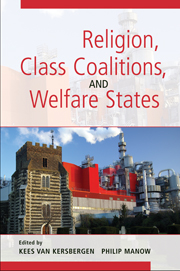Book contents
- Frontmatter
- Contents
- Preface
- List of Contributors
- 1 Religion and the Western Welfare State – The Theoretical Context
- 2 Western European Party Systems and the Religious Cleavage
- 3 The Religious Foundations of Work-Family Policies in Western Europe
- 4 Italy: A Christian Democratic or Clientelist Welfare State?
- 5 Religion and the Welfare State in the Netherlands
- 6 A Conservative Welfare State Regime without Christian Democracy? The French État-Providence, 1880–1960
- 7 Religion and the Consolidation of the Swiss Welfare State, 1848–1945
- 8 The Church as Nation? The Role of Religion in the Development of the Swedish Welfare State
- 9 The Religious Factor in U.S. Welfare State Politics
- 10 Religious Doctrines and Poor Relief: A Different Causal Pathway
- Index
5 - Religion and the Welfare State in the Netherlands
Published online by Cambridge University Press: 28 January 2010
- Frontmatter
- Contents
- Preface
- List of Contributors
- 1 Religion and the Western Welfare State – The Theoretical Context
- 2 Western European Party Systems and the Religious Cleavage
- 3 The Religious Foundations of Work-Family Policies in Western Europe
- 4 Italy: A Christian Democratic or Clientelist Welfare State?
- 5 Religion and the Welfare State in the Netherlands
- 6 A Conservative Welfare State Regime without Christian Democracy? The French État-Providence, 1880–1960
- 7 Religion and the Consolidation of the Swiss Welfare State, 1848–1945
- 8 The Church as Nation? The Role of Religion in the Development of the Swedish Welfare State
- 9 The Religious Factor in U.S. Welfare State Politics
- 10 Religious Doctrines and Poor Relief: A Different Causal Pathway
- Index
Summary
INTRODUCTION
Two major puzzles have occupied research on the Dutch welfare state. First, why was social policy so late to emerge, and why did it remain underdeveloped for such a long time? Second, why did the Dutch welfare state in the period after World War II so suddenly and rapidly expand to become one of the most comprehensive, generous, and passive of its sort? The second puzzle is to some extent the reverse image of the first because ‘catching up’ is only possible for a country that first lagged behind European developments. The generosity and passive character of the Dutch welfare state in the 1960s and 1970s, however, are a distinct conundrum.
As is stressed in the introductory chapter of this volume, there are three major sources of variation in welfare state development: the timing of the development of the self-regulating market in the 19th century, the long-standing religious differences since the Reformation, and the cleavage structuring in politics as an effect of the choice of electoral system in the beginning of the 20th century (in the Dutch case, in 1917). Measured against such indicators as wealth and urbanization, the Netherlands between 1850 and 1890 qualifies as a developed and modernized economy that, according to the modernization tradition in welfare state research, should have developed modern social policies early on. Because it did not, the country can be classified as a welfare state laggard or latecomer. The country's economic wealth and development stemmed from commerce, shipping, agriculture, banking, and finance.
- Type
- Chapter
- Information
- Religion, Class Coalitions, and Welfare States , pp. 119 - 145Publisher: Cambridge University PressPrint publication year: 2009
- 14
- Cited by

